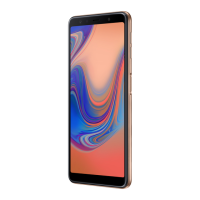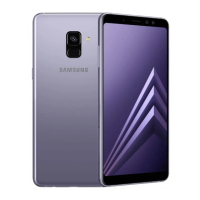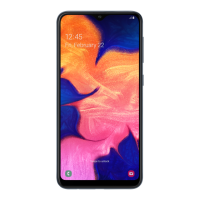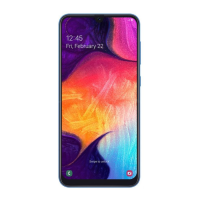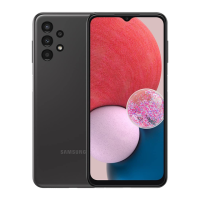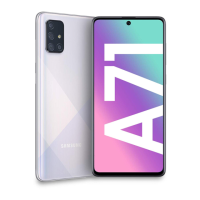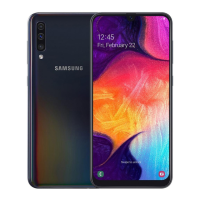Do you have a question about the Samsung Galaxy A6+ and is the answer not in the manual?
Guidance on what to do when the device becomes hot during charging.
Reasons and steps for device overheating during normal usage.
Important precautions regarding the environment to prevent device damage.
Instructions and safety precautions for charging the device's battery.
Tips and settings to conserve the device's battery power.
Additional advice and warnings related to battery charging.
Step-by-step guide for inserting a SIM or USIM card.
Instructions and precautions for installing a microSD card.
Instructions for powering the device on, off, and restarting it.
Step-by-step guide for the initial setup of the device.
Methods for transferring data using Smart Switch and Wi-Fi Direct.
Steps to back up device data to Samsung Cloud.
Steps to restore device data from Samsung Cloud.
Options for setting screen lock types like pattern, PIN, password, face, fingerprint.
Service for information retrieval using object recognition.
Steps for taking photos and recording videos with the camera.
Steps to set up Samsung Pay, including account sign-in and PIN creation.
How to easily register payment cards using the device's camera.
Steps for making payments using Samsung Pay.
Monitoring health and fitness, tracking progress, and competing with friends.
Using the app to record or play voice memos.
Accessing and managing files stored on the device and cloud.
Steps for setting and configuring alarms in the Clock app.
Performing simple or complex calculations with the calculator app.
Instructions for listening to FM radio, including connecting a headset.
Activating and using the Game Launcher app.
Changing settings for Wi-Fi, Bluetooth, and other connections.
Connecting to Wi-Fi networks for internet access.
Steps to connect the device to a Wi-Fi network.
Exchanging data or media files with other Bluetooth-enabled devices.
Steps to pair the device with other Bluetooth devices.
Reducing mobile data usage by preventing background app data consumption.
Using NFC for reading tags, making payments, and buying tickets.
Using NFC to make payments after registering a mobile payment service.
Steps to set up and use the mobile hotspot feature.
Activating and customizing SIM/USIM card settings for dual SIM devices.
Configuring notification settings for apps and displaying badges.
Reducing mobile data usage and compressing internet data.
Setting up face recognition for unlocking the screen.
Steps to register your face for screen unlocking.
Using face recognition to unlock the device screen.
Registering fingerprints for device security and app authentication.
Steps to register your fingerprints on the device.
Using fingerprints with Samsung Pay for secure payments.
Registering biometric data for Samsung Pass.
Steps to set up and launch the Secure Folder app.
Resetting device settings or performing a factory data reset.
Updating device software via FOTA service and scheduling updates.
Information about device security updates.
Solutions for device prompts, network errors, and power issues.
Troubleshooting slow or improper touchscreen response.
Solutions for device freezes, including restarting and factory reset.
Troubleshooting problems with calls not connecting.
Troubleshooting echo or others not hearing you during calls.
Troubleshooting disconnected networks or poor audio quality.
Troubleshooting when the battery icon indicates low power.
Troubleshooting issues with battery charging.
Understanding why battery life may decrease over time.
Troubleshooting error messages when launching the camera app.
Troubleshooting errors when opening or playing multimedia files.
Troubleshooting problems with Bluetooth connections.
Troubleshooting device connection problems with a computer.
Troubleshooting GPS signal obstructions for location services.
Importance of backups and troubleshooting data loss.
Freeing up storage space by deleting unnecessary data.
Safety precautions and instructions for battery removal.
Guidance on what to do when the device becomes hot during charging.
Reasons and steps for device overheating during normal usage.
Important precautions regarding the environment to prevent device damage.
Instructions and safety precautions for charging the device's battery.
Tips and settings to conserve the device's battery power.
Additional advice and warnings related to battery charging.
Step-by-step guide for inserting a SIM or USIM card.
Instructions and precautions for installing a microSD card.
Instructions for powering the device on, off, and restarting it.
Step-by-step guide for the initial setup of the device.
Methods for transferring data using Smart Switch and Wi-Fi Direct.
Steps to back up device data to Samsung Cloud.
Steps to restore device data from Samsung Cloud.
Options for setting screen lock types like pattern, PIN, password, face, fingerprint.
Service for information retrieval using object recognition.
Steps for taking photos and recording videos with the camera.
Steps to set up Samsung Pay, including account sign-in and PIN creation.
How to easily register payment cards using the device's camera.
Steps for making payments using Samsung Pay.
Monitoring health and fitness, tracking progress, and competing with friends.
Using the app to record or play voice memos.
Accessing and managing files stored on the device and cloud.
Steps for setting and configuring alarms in the Clock app.
Performing simple or complex calculations with the calculator app.
Instructions for listening to FM radio, including connecting a headset.
Activating and using the Game Launcher app.
Changing settings for Wi-Fi, Bluetooth, and other connections.
Connecting to Wi-Fi networks for internet access.
Steps to connect the device to a Wi-Fi network.
Exchanging data or media files with other Bluetooth-enabled devices.
Steps to pair the device with other Bluetooth devices.
Reducing mobile data usage by preventing background app data consumption.
Using NFC for reading tags, making payments, and buying tickets.
Using NFC to make payments after registering a mobile payment service.
Steps to set up and use the mobile hotspot feature.
Activating and customizing SIM/USIM card settings for dual SIM devices.
Configuring notification settings for apps and displaying badges.
Reducing mobile data usage and compressing internet data.
Setting up face recognition for unlocking the screen.
Steps to register your face for screen unlocking.
Using face recognition to unlock the device screen.
Registering fingerprints for device security and app authentication.
Steps to register your fingerprints on the device.
Using fingerprints with Samsung Pay for secure payments.
Registering biometric data for Samsung Pass.
Steps to set up and launch the Secure Folder app.
Resetting device settings or performing a factory data reset.
Updating device software via FOTA service and scheduling updates.
Information about device security updates.
Solutions for device prompts, network errors, and power issues.
Troubleshooting slow or improper touchscreen response.
Solutions for device freezes, including restarting and factory reset.
Troubleshooting problems with calls not connecting.
Troubleshooting echo or others not hearing you during calls.
Troubleshooting disconnected networks or poor audio quality.
Troubleshooting when the battery icon indicates low power.
Troubleshooting issues with battery charging.
Understanding why battery life may decrease over time.
Troubleshooting error messages when launching the camera app.
Troubleshooting errors when opening or playing multimedia files.
Troubleshooting problems with Bluetooth connections.
Troubleshooting device connection problems with a computer.
Troubleshooting GPS signal obstructions for location services.
Importance of backups and troubleshooting data loss.
Freeing up storage space by deleting unnecessary data.
Safety precautions and instructions for battery removal.
| Screen shape | Flat |
|---|---|
| Display diagonal | 6 \ |
| Touch technology | Multi-touch |
| Touchscreen type | Capacitive |
| Display resolution | 1080 x 2220 pixels |
| Native aspect ratio | 18.5:9 |
| Rounded display corners | Yes |
| Processor cores | 8 |
| Processor family | Qualcomm Snapdragon |
| Processor frequency | 1.8 GHz |
| Processor architecture | ARM Cortex-A53 |
| User memory | 22.4 GB |
| RAM capacity | 3 GB |
| Memory card slot type | Dedicated slot |
| Compatible memory cards | MicroSD (TransFlash) |
| Maximum memory card size | 256 GB |
| Internal storage capacity | 32 GB |
| Flash type | LED |
| Rear camera type | Dual camera |
| Front camera type | Single camera |
| Maximum frame rate | 30 fps |
| Video recording modes | 1080p |
| Rear camera aperture number | 1.7 |
| Rear camera resolution (numeric) | 16 MP |
| Front camera resolution (numeric) | 24 MP |
| Second rear camera aperture number | 1.9 |
| Second rear camera resolution (numeric) | 5 MP |
| 4G standard | LTE |
| 2G standards | GPRS, GSM |
| 3G standards | WCDMA |
| SIM card type | MicroSIM |
| Wi-Fi standards | 802.11a, Wi-Fi 5 (802.11ac), 802.11b, 802.11g, Wi-Fi 4 (802.11n) |
| Bluetooth version | 4.2 |
| SIM card capability | Dual SIM |
| Mobile network generation | 4G |
| Subscription type | No subscription |
| USB version | 2.0 |
| USB connector type | Micro-USB |
| Headphone connectivity | 3.5 mm |
| Multimedia Messaging Service (MMS) | Multimedia Messaging Service (MMS) is a standard way to send messages that include multimedia content to and from a mobile phone over a cellular network |
| Form factor | Bar |
| Product color | Black |
| Themes | Wallpapers |
| Graphics card | Adreno 506 |
| Personalization | Icons, Menu, Shortcuts |
| Wireless charging | - |
| Personal info management (PIM) | Alarm clock, Calculator, Calendar |
| Audio formats supported | 3GA, AAC, AMR, AWB, FLAC, IMY, M4A, MID, MIDI, MP3, MXMF, OGA, OGG, OTA, RTTTL, RTX, WAV, WMA, XMF |
| Video formats supported | 3G2, 3GP, ASF, AVI, FLV, MKV, MP4, WEBM |
| Platform | Android |
| Google applications | Google Chrome, Google Maps, YouTube |
| App distribution platform | Google Play |
| Operating system installed | Android 8.0 |
| Talk time (3G) | 21 h |
| Battery capacity | 3500 mAh |
| Browsing time (3G) | 13 h |
| Browsing time (4G) | 14 h |
| Browsing time (Wi-Fi) | 15 h |
| Continuous audio playback time | 60 h |
| Continuous video playback time | 18 h |
| Continuous audio playback time (display off) | 120 h |
| Depth | 7.9 mm |
|---|---|
| Width | 75.7 mm |
| Height | 160.2 mm |
| Weight | 191 g |

